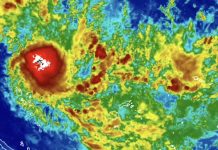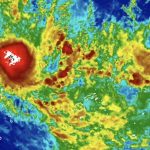Within a few months, Japan is expected to release treated wastewater from the damaged Fukushima Daiichi nuclear power plant into the Pacific Ocean.
So what exactly is happening, and what are the risks?
What’s getting released?
Water used to cool nuclear reactors which were damaged in the 2011 nuclear disaster.
Japanese authorities used 1.3 million tonnes of water to cool the reactors following the disaster which was triggered by an earthquake and ensuing tsunami.
The water is currently being stored in tanks onsite, and the plant is running out of space. Pre-treatment, the water contains several dangerous radioactive isotopes, including caesium, iodine and strontium.
A treatment process called Advanced Liquid Processing System (ALPS) should remove these and about 60 other contaminants, but the treated water will still contain radioactive hydrogen and carbon-14.
“The radioactivity in the Fukushima water is almost entirely tritium, a form of hydrogen,” says Associate Professor Nigel Marks, a physicist at Curtin University.
“For scale, the Pacific Ocean contains 8,400 grams of pure tritium, while Japan will release 0.06 grams of tritium every year.”
Is the tritium from Fukushima safe?
“The minuscule amount of extra radiation won’t make the tiniest jot of difference,” says Marks.
“A lifetime’s worth of seafood caught a few kilometres from the ocean outlet has the tritium radiation equivalent of one bite of a banana.”
Associate Professor Tony Hooker, a physicist at the University of Adelaide, says he wouldn’t drink the water – not because of the radiation, but because it’s seawater.
“Tritium is released from nuclear facilities all around the world routinely and has been for decades,” says Hooker.
“I would drink the water,” counters Dr David Krofcheck, a physicist at the university of Auckland, New Zealand.
“It’s like going down to the beach and swallowing a mouthful of water when you’re swimming.”
Hooker says that while he doesn’t expect any radiation risk, there may be other environmental factors to take into account.
“Whilst this disposal plan meets the scientific and regulatory requirements for the disposal of radiation into the sea, and no environmental or human health impacts are likely to be observed, there is a growing question regarding the use of the sea as a dumping ground when our oceans are already stressed and struggling,” says Hooker.
“Dilution is no longer the solution to pollution, so whilst the Japanese may dispose of their wastewater in the interim, it would be a good opportunity to look at other disposal methodologies in the future.”
Do they know exactly what’s in the water at Fukushima?
No – but they will know what’s in each batch by the time it’s released.
“The Japanese have 1000 tanks. They probably only really know what’s in 40 percent of them with any level of accuracy,” says Hooker.
“But what we do know is that water gets filtered through that ALPS process. The water then gets tested, and if there’s any residual radionuclides still remaining, it goes through that ALPS process again.”
Some batches may need to be processed several times, according to Hooker.
Is the filtration process safe?
The ALPS process has been developed by the Tokyo Electric Power Company (TEPCO), which is running the Fukushima operation, and the Japanese government.
The International Atomic Energy Agency (IAEA) has verified the process independently and deemed it reliable.
“The IAEA have carried out a series of missions. Their latest report, issued May 2023, reviews the determination of radionuclides in ALPS-treated water,” explains Tony Irwin, technical director of SMR Nuclear Technology and chair of Engineers Australia’s Sydney division nuclear engineering panel.
“Samples were taken from the first batch of ALPS-treated water expected to be discharged into the sea and independently analysed by TEPCO, by the IAEA at its labs in Monaco, Seibersdorf and Vienna, and in third-party labs in France, South Korea, Switzerland and the USA.
“The results show a very high level of agreement between all the labs. Importantly, neither the IAEA, nor the participating third-party laboratories, detected any additional radionuclides (i.e. radionuclides beyond what is included in the source term) at significant levels.”
Does it have to go into the ocean?
Several destinations for the water have been suggested.
The Independent Expert Panel to the Pacific Islands Forum, of which Hooker is a member, has proposed turning the water into concrete.
“One of the other issues that you do have is that there are regulatory barriers for using radioactive waste for a commercial product,” says Hooker.
Hooker says that there “used to be a market for tritium”, particularly in lighting, but this has dwindled.
Krofcheck is of the opinion that “release into the ocean with the dilution and the ALPS processing is the least bad option”, as concrete can still be eroded by seawater.
Where will the water go?
It’s difficult to track the movement of ocean water, but erupting volcanoes and shipping accidents have given us some clue as to how ocean currents have moved about in the past.
Professor Chau-Ron Wu, a fellow at the Research Centre for Environmental Changes in Academia Sinica, Taiwan, estimates that the released water will be at Taiwan’s shores in roughly a year, and they’ll take 2-3 years to get to North America.
He doesn’t know how long it will take for the waters to get to the Southern Hemisphere. Historically, it has taken less than a year for material from the northwest Pacific to make it across the equator.
SOURCE: COSMOS MAGAZINE/PACNEWS














